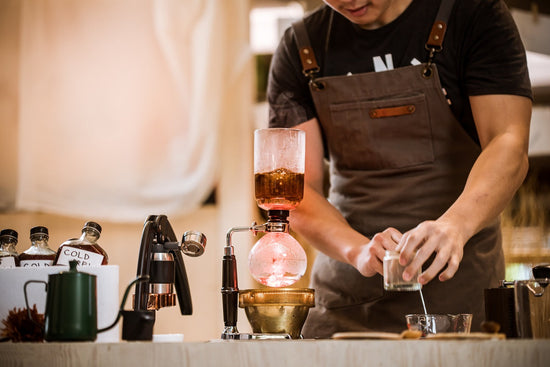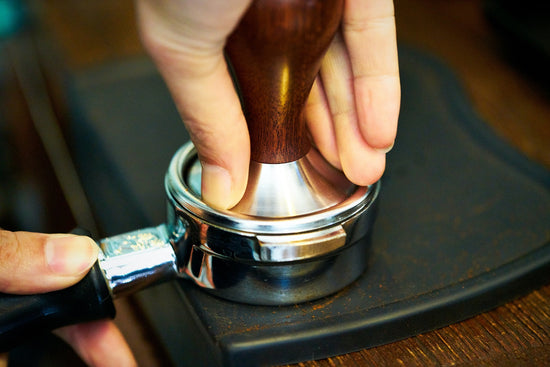In the world of coffee aficionados and casual drinkers alike, the pursuit of the perfect cup is a journey marked by exploration, experimentation, and a deep appreciation for the nuances of this beloved beverage. Amidst the various stages of coffee brewing, one aspect that often remains overlooked yet profoundly influences the final outcome is the coffee bloom. This initial phase of brewing carries significant weight in determining not only the quality but also the flavour profile of the resulting cup. Delving into the science behind coffee bloom and understanding its impact on taste can elevate one's coffee experience to new heights.
What is Coffee Bloom?
At the onset of coffee brewing, the coffee bloom takes centre stage. This phenomenon occurs as freshly ground coffee comes into contact with hot water, initiating the release of carbon dioxide (CO₂) gas trapped within the coffee grounds.
The rapid liberation of CO₂ causes the coffee grounds to swell and bubble, resembling the unfurling petals of a blooming flower.
This visual spectacle, hence aptly named the "coffee bloom," is particularly pronounced in brewing methods such as pour-over, French press, and Aeropress, where the interaction between water and coffee grounds is more conspicuous.

The Science Behind Coffee Bloom
The science underpinning the coffee bloom is rooted in the composition of freshly roasted coffee beans. During the roasting process, coffee beans undergo thermal degradation, leading to the formation of various volatile compounds and the retention of CO₂ within the bean structure. Upon grinding and subsequent exposure to hot water, the trapped CO₂ is swiftly liberated, propelling the blooming effect observed during brewing. The intensity of the bloom correlates with the freshness of the coffee; fresher beans typically exhibit a more vigorous bloom due to higher levels of trapped gases.

"All good things begin with 'c', carrots, coffee and country"
Why Does Coffee Bloom Matter?
Beyond its aesthetic appeal, the coffee bloom holds profound implications for the flavour profile and overall quality of the brewed coffee. Here's why the bloom matters:
Uniform Extraction : The blooming phase facilitates even saturation of the coffee grounds with water, laying the groundwork for uniform extraction. This consistency is pivotal in achieving balanced flavours, mitigating the risk of under-extraction resulting in sour, weak coffee or over-extraction leading to bitterness.
Flavour Release : The release of CO₂ during the bloom phase serves as a catalyst for the extraction of aromatic compounds and flavours inherent in the coffee grounds. Optimal blooming ensures the unhindered release of these flavour constituents, enhancing the overall complexity and depth of the brewed coffee.
Indicator of Freshness : A robust and lively bloom serves as a tangible indicator of coffee freshness. Stale beans, lacking in trapped CO₂, typically exhibit a feeble or absent bloom, signalling diminished quality. Thus, the bloom phase offers invaluable insight into the freshness and integrity of the coffee beans.

How to Achieve the Perfect Coffee Bloom
Realising the full potential of the coffee bloom necessitates meticulous attention to detail and a nuanced understanding of the brewing process. Here are actionable steps to optimise the blooming phase:
Start with Freshly Roasted Beans
The cornerstone of a vibrant coffee bloom lies in the freshness of the coffee beans. Prioritise beans roasted within the optimal timeframe, ideally consumed within two to four weeks post-roasting to maximise flavour retention and CO₂ content.
Grind Just Before Brewing
Minimise pre-brewing exposure by grinding your coffee beans immediately before brewing. This practice preserves volatile aromatics and ensures the integrity of the bloom-inducing CO₂ within the grounds.

Employ Proper Brewing Techniques
Adopt brewing methods that facilitate adequate blooming, such as pour-over, French press, or Aeropress. Maintain consistent water-to-coffee ratios and employ gentle agitation to encourage uniform saturation and extraction.
Observe and Adjust
Monitor the blooming process closely during brewing. Note the intensity and duration of the bloom, adjusting parameters such as grind size, water temperature, and agitation as needed to optimise extraction and flavour development.

Conclusion
In the intricate tapestry of coffee brewing, the coffee bloom emerges as a pivotal stage with far-reaching implications for taste, quality, and overall coffee enjoyment. Embracing the science behind the bloom and implementing strategies to harness its potential can unlock a realm of flavour complexity and sensory delight. By prioritising freshness, precision, and attentive brewing techniques, coffee enthusiasts can elevate their brewing prowess and savour the delightful nuances encapsulated within each blooming cup of coffee. So, the next time you embark on your coffee brewing journey, pause to witness the mesmerising dance of the coffee bloom—a prelude to the sensory symphony that awaits in every sip.
At Redber Coffee, we believe in exploring the spectrum of possibilities. We offer a variety of roast profiles for each coffee origin, catering to diverse palates. Whether you crave a bright and lively cup or a smooth and mellow experience, we have a roast curve that will tantalize your taste buds.
Frequently Asked Questions
1. What causes the coffee bloom?
- The coffee bloom occurs due to the rapid release of carbon dioxide (CO₂) gas trapped within freshly ground coffee beans. During the roasting process, CO₂ becomes embedded within the bean structure. When hot water is introduced to the coffee grounds during brewing, the trapped CO₂ is liberated, causing the characteristic blooming effect. blooming effect.
2. How long does the coffee bloom last?
- The duration of the coffee bloom varies depending on factors such as coffee freshness, grind size, and brewing method. Typically, the bloom phase lasts anywhere from 30 seconds to a minute, with the intensity gradually diminishing as the brewing process progresses.
3. Does the coffee bloom affect the taste of the final cup?
Yes, the coffee bloom significantly influences the taste of the final cup. A vigorous bloom ensures even saturation of the coffee grounds, leading to uniform extraction and optimal flavour development. The release of CO₂ during blooming also enhances the extraction of aromatic compounds, contributing to a more complex and nuanced flavour profile.
4. How can I tell if my coffee beans are fresh based on the bloom?
Fresh coffee beans will produce a robust and lively bloom, characterised by vigorous bubbling and expansion of the coffee grounds. Stale beans, on the other hand, will exhibit a weak or non-existent bloom, indicating diminished freshness and flavour potential.
Products Featured In This Blog



